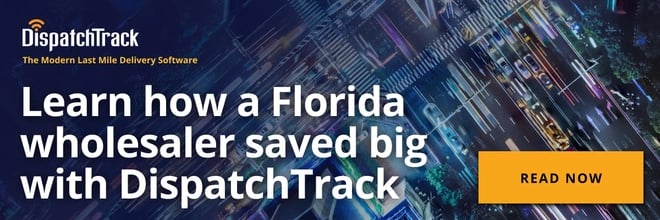For businesses that have to deal with them, delivery operations will always account for a substantial percentage of an organization's operating costs. There are drivers to be paid, fuel to purchase, and vehicles to buy and maintain. If you’re working with a 3PL, those costs still exist, they just come to you via a different line item. Luckily, deploying logistics software for trucking can reduce your fleet's operating costs and thereby improve your margins.

That said, not all trucking software is created equal. The right solution for carriers can solve many of your company's most complex and time-consuming problems—but technology tends to be a big investment (in addition to monthly licensing costs, you’re often looking at the cost of training, change management, etc.), and there’s no guarantee that a given piece of software will yield a positive ROI.
This raises the question: how can you tell if your logistics software for trucking is wasting money instead of generate the benefits it should?
5 Signs You're Losing Money on Your Logistics Software for Trucking
Operating Costs Are Accelerating Faster than Revenues
Getting more orders from current customers and gaining new ones usually bodes well for any company. But the volume of orders alone is not an indicator of a company's success. Sure, an entity may be experiencing an increase in revenues, but how does the figure compare to its operating costs?
Many B2B customers, after all, have shown increasing demands that include more frequent deliveries, tighter delivery time frames, smaller shipments, and more accurate expected time of arrivals (ETAs). All these consumer expectations are hard to meet, as businesses have to balance consumer demands with the larger order volumes.
To deal with higher volumes, some companies hire additional drivers, purchase new delivery vehicles, and add standalone routes to meet the higher volumes and consumer expectations. These kinds of capital expenses are sometimes necessary—but they involve a big risk, especially if order volumes begin to drop off. At the same time, not every business is in a position to scale easily even with new trucks—and the result is a decrease in operational efficiency as you try to expand capacity.
In other words, your company may meet the increased delivery demands, thanks to new acquisitions of assets and talent, but your operating costs can be increasing faster than your revenue. If you find yourself in this situation, it often means that your trucking logistics software and your business processes aren’t built to scale—meaning that your ROI will shrink.
Inactive Assets
Demand changes day-by-day or season per season, which means fleets don't need every single one of their delivery vehicles to ferry goods at full capacity daily.
However, if you’re seeing a high number of vehicles regularly parked for over two days, it might be a sign that your existing trucking software isn’t helping you to optimize capacity utilization. The right solution can and should help you match demand to capacity in an efficient way, so that your assets aren’t sitting unused.

Poor Customer Service Scores
Unhappy customers can damage a brand. Consumers, after all, can refuse to patronize a business, share their bad experience from a company with their friends, and leave poor online reviews. Companies that fail to meet customer demands can expect the loss of customers along with a barrage of urgent requests to correct deliveries.
Poor customer service often gets blamed on drivers, but if we’re talking about something like consistently missed delivery windows, the real culprit might be your route planning technology. If your routing software can’t produce routes that come with accurate, precise ETAs, you’re setting yourself for disgruntled customers. Not only does this have the potential to increase customer churn, it can also increase inbound call volumes to customer support and result in poor planned vs. actual delivery completions each day.
Poor ETAs are a technology problem, plain and simple. If your logistics software for trucking can’t offer them, it’s probably costing you money.
Manual Planning of Delivery Routes
In the section above, we assumed that your software solution involved some amount of route optimization. Sub-optimal route optimization can be an issue, but a complete lack of route optimization is also a huge red flag.
Companies that find themselves having employees prepare route plans manually are often unable to keep up with on-demand deliveries. Manual route planning simply doesn’t scale—which is why human route planners and fleet managers should not spend hours finding the best routes for their fleets. Instead, they should be able to focus on handling exceptions and making strategic decisions.
To make this possible, you need an advanced, efficient route planner that can provide the optimal routes in just a few minutes—using advanced algorithms that can evaluate millions of possible routes while taking into consideration the many variables affecting delivery times.
In addition to not scaling, manually planned routes tend to be significantly less efficient than the routes provided by software. This means companies are racking up unnecessary fuel and labor costs both in the back office and out in the field.
Poor Logistics Software Visibility
Fleets that have already automated their route planning but are unable to connect their route planning software with their in-cab telematics are likely to be missing out on huge cost savings. The lack of connection between the route planning software and in-cab telematics results in poor visibility on whether the drivers are following the route plans provided to them.
Fleets need to have real-time monitoring capabilities so they can see where their drivers are at any given time. Real-time tracking allows fleet managers which drivers are delivering out of sequence, are non-compliant with planned routes, and are exceeding planned miles. If you can’t compare planned vs. actual routes, you lack the visibility to really optimize costs.
By the same token, if you can’t track orders in real time, you also lack the visibility to provide proactive customer service and exception management. Keep in mind: visibility isn’t just about what information you’re gathering, it’s about how easy it is to find that information. If it takes you thirty minutes scrolling through three different applications to find out which orders are late or haven’t been completed, you’ll likely find yourself struggling to stay agile in resolving issues.
Information goes stale quickly in shipping. But if your trucking logistics software can help you reach the right information more quickly, it’s much more likely to offer you a measurable positive ROI.